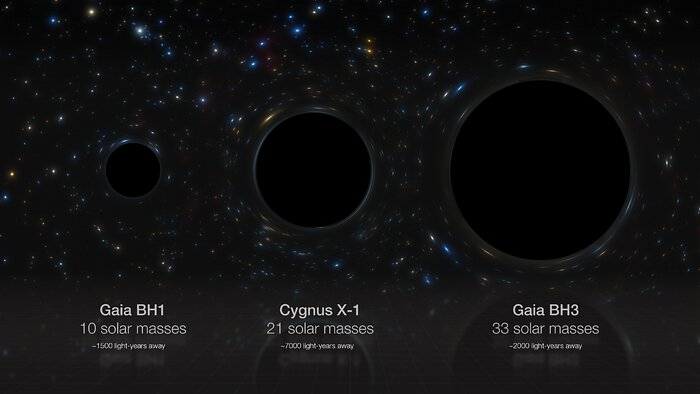A newly discovered black hole has a mass 33 times that of the Sun. This comfortably exceeds the previous record for a stellar black hole in our galaxy, which was around 20 solar masses, and has helped confirm theories about how an object of this mass could form.
The largest stars end their lives as supernovae that produce black holes from their cataclysmic explosions. These black holes have considerably less mass than the stars they came from because so much has been thrown off during their lifetime and in the supernova event.
Without question, many such black holes are lurking in our galaxy that we have little chance of spotting. Fortunately, a large proportion of the exploding stars were part of binary systems, or sometimes even larger groups, when they lived. Some companions get thrown off by the force of the supernova to wander the galaxy alone, but those that are more massive or more distant survive and orbit the black hole, alerting us to its presence.
When stars are observed to wobble on a regular basis it means that some other object’s gravity is affecting them. Sometimes this can be a fainter star we can’t see – or even a planet – but in the case of one new discovery, that’s not possible. The object causing the star 2MASS J19391872+1455542 to make an 11.6-year circle has a mass thousands of times greater than the largest planet. If it was a star, it would be so intensely bright we could probably see it with the naked eye.
An invisible mass that big has to be a black hole – one around 50 percent bigger than Cygnus X-1, our galaxy’s previous largest known remnant of such an explosion.

Gaia BH3 compared with the largest stellar black hole we had previously discovered, and a typical example. Black holes’ mass is proportional to their radii, not their volume.
Image Credit: ESO/M. Kornmesser
The discovery was made by combing through data from the Gaia telescope, which tracks the movements of the stars with staggering precision. It’s the third time this type of search has led to such a discovery, so the object is known as Gaia BH3. Besides its immense mass, Gaia BH3 is 2,000 light-years away in the constellation Aquila – not quite down the street, but if the Milky Way was a large city, this would be the next suburb.
“No one was expecting to find a high-mass black hole lurking nearby, undetected so far,” said Pasquale Panuzzo of the Observatoire de Paris in a statement. “This is the kind of discovery you make once in your research life.”
Gaia observations alone might have some other cause, but a large international team used the European Southern Observatory’s Very Large Telescope (VLT) to confirm the measurements and reveal more.
We might expect that if objects like this can be overlooked in our own galaxy, we’d know nothing of their presence elsewhere. Surprisingly, that is wrong. Gravitational waves have alerted us to the existence of even larger stellar black holes billions of light years away. However, since this only works when two objects whose mutual orbit has decayed collide it happens very rarely, and we only know of a handful of cases, all at vast distances.
Astronomers’ working hypothesis for such large black holes, which have exceeded expectations, is that they come from very metal-poor stars: ones formed almost entirely from the hydrogen and helium produced in the Big Bang. Such stars had the potential to be far more massive than those in the modern universe. They’re also thought to lose less mass through stellar winds, preserving that mass to black hole formation.
It’s an idea that makes sense, but one we can’t prove using black holes detected by gravitational waves. That has changed with Gaia BH3. Stars in binary systems usually have similar compositions, other than in the rare cases where they didn’t form together, or the somewhat more common ones where one star ate a planet large enough to noticeably boost its metal content.
Using the VLT’s Ultraviolet and Visual Echelle Spectrograph Dr Elisabetta Caffau and co-authors confirmed that J19391872+1455542 is indeed very metal-poor, making it likely the star that became Gaia BH3 was too. J19391872+1455542 is a very old star, as we would expect for something so metal-poor, and despite having a mass three-quarters that of the Sun has begun the process of turning into a red giant.
A full analysis of Gaia BH3 will not come until at least late 2025, but the team responsible for the discovery wanted to give other astronomers a chance to take a look themselves, maximizing the opportunities to learn more.
The discovery is published open access in the journal Astronomy and Astrophysics.
Source Link: Milky Way’s Newly Record-Breaking Stellar Black Hole Has The Mass Of 33 Suns